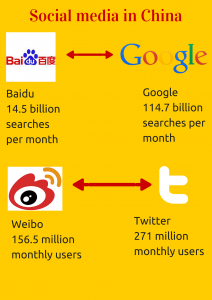
“With its distinctive and unique nature, new media has brought human interaction and society to a highly interconnected and complex level.”
According to communications researcher Guo-Ming Chen, the advent of social media has shrunk time and space bringing together societies that were previously separated.
With the power of social media driving this age of globalization, social media in other countries is changing how international public relations is viewed and conducted.
How has social media in other countries driven globalization?
Globalization, defined by Chen as the “social process in which the constraints of geography on social and cultural arrangements recede and people become increasingly aware that they are receding”, comes with many pros and cons. Social media platforms contribute to this list by opening new communications channels between geographically-dispersed publics and bringing their issues to the forefront.
I’ve often wondered how my mother, who lived in Germany in the 1980s, was able to get by with only the occasional news from home – a once-a-month phone call and twice -a-month letters from the post. Today as I live abroad, I’m consistently connected to colleagues, friends and family back in the States through the various social media platforms I’m active on.
If I have an issue with a U.S. government entity, I can still address it almost immediately even from another continent. When a company messes something up, I have an entire listening audience I can vent to. No matter if there are oceans between you and the organization or if it’s next door, social media has given consumers a platform to either praise or criticize from they’ve never before enjoyed (or abused).
As more and more countries come online, social media is bringing people together like never before. From these multicultural interactions, international public relations is learning how to target diverse cultures and create culturally-sensitive content that appeals to these new segments. To be successful in these new strategies, marketers need to understand how each country they are focusing on uses social media.
How is social media in other countries used?
Focusing on the three countries I’ve lived and worked in during the past two years, these insights come from my experiences and discussions with other communications professionals from each nation.
Brazil
As a country known for its warm climate as much as its warm people, Brazil has become the social media capital of emerging nations. Sharing and socializing are important to the culture, and as the middle class has grown, Brazilians have flocked online to platforms that allow them to expand these values.
As with many other countries worldwide, Facebook dominates as the most used social network in Brazil. Other platforms not so popular in the States to watch in the country, though, include Badoo, a dating-focused social network where users meet new people, and Kekanto, a review site like Yelp. VKontacte, a Russian social media platform, is also growing in Brazil as it scoops up former users of the now defunct Orkut, Google’s first attempt at a social network.
Visual content has shown to do well in the Brazilian market. As the largest YouTube market outside of the U.S., video is a dominant form of content in Brazil. Content marketers are well advised to create video with captivating music to gain attention in the country.
Switzerland
I’ve said that moving from Brazil to Switzerland in February was as complete of a culture shock as anyone could receive. From warmth to cold in all areas, Switzerland also shows this flip in its social media culture.
Relationships here are still very much formed offline. As Facebook again leads for most popular social network, nothing can replace the face-to-face interaction the Swiss prefer. As a reserved culture, sharing and interacting online are not as important as meeting in person. One social network specific to the country is Xing, a LinkedIn-like professional network more popular in the German-speaking region. WhatsApp, a mobile messaging service, is also widely used among teenagers and young adults in the country.
With the many languages and cultures represented in Switzerland, marketers need to internally segment audiences carefully and direct their efforts in a culturally-sensitive manner. As in-person networking is more important, use Meetup to plan events that can also be followed up in the online world.
China
We’re talking a whole different ballgame here. With mainstream social media platforms, like Facebook and Twitter, blocked by the Chinese government, the world’s largest nation by population has created a social media industry all its own.
There is a wealth of insider knowledge for conducting social media operations in China, and to get started you need to know what the main Chinese social media platforms are. Check out this infographic for a breakdown.
The Chinese are drawn to new and game-changing concepts. Follow the laws and use these Chinese homegrown platforms to create innovative ideas and events around your product.
How are other countries using social media?
Each nation approaches social media marketing in its own culturally-aware fashion.
What are some other ways countries you’ve been to are using social media?





